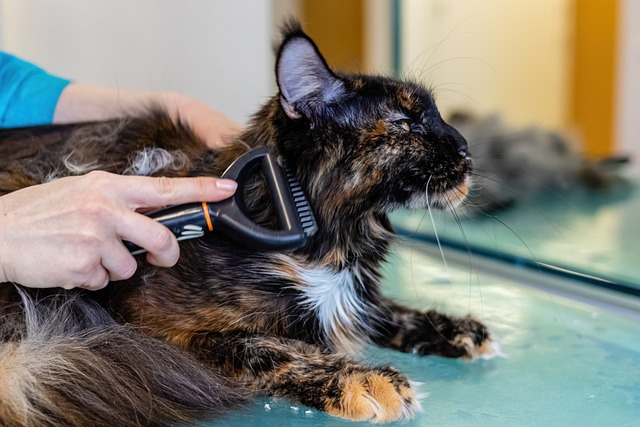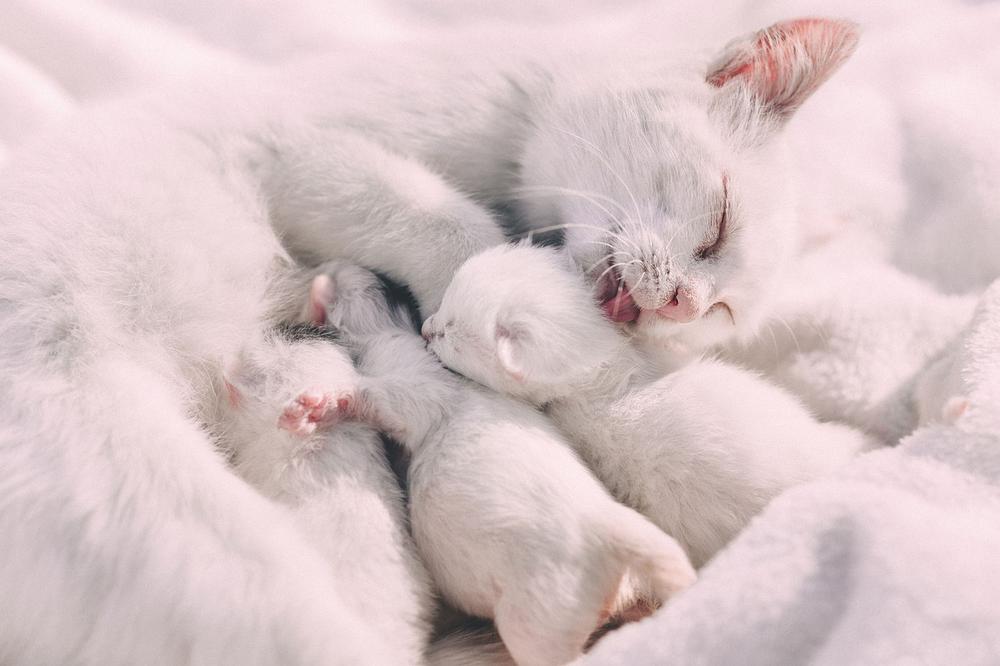How Often Should You Brush Your Cat? (Detailed Answer)

You'll agree with me when I say:
Brushing your cat can be a real pain in the tail.
I mean, who has the time and energy to chase a furball around, right?
And what if your cat turns into a wild, hissing monster every time you come near with a brush? 🐯
It's like wrestling a snarling tiger in the jungle.
But fear not, my feline-loving friend, because today we're going to tackle the age-old question:
"How often should I brush my cat?"
Let's begin, shall we?
How Often Should I Brush My Long-Haired Cat?
When you're brushing your long-haired cat, there are a few things you should think about. First, consider how active your cat is and what their lifestyle is like. 🐱
This will help you figure out how often you need to brush them.
Generally, it's recommended to brush long-haired cats once or twice a week.
But if your furry friend has medium-length hair, you might have to brush them a few times a week or even every day.
For short-haired cats, a weekly brushing usually does the trick.
However, PLEASE bear in mind that these are just general suggestions. Some cats might need more grooming depending on their specific needs.
If your cat's fur has tangles or mats, you might have to brush them daily.
And older cats or those with mobility issues might benefit from more frequent brushing to keep their coats healthy.
Lastly, remember that during high shedding seasons, you'll have to brush your cat more often to manage all the extra fur.
By considering these factors, you'll be able to determine how often to brush your long-haired cat and keep them looking fabulous.
Now, here's the deal - brushing your cat not only keeps their coat beautiful but also brings several benefits for both you and your feline friend.
But how exactly should you brush them to ensure a comfortable experience?
Let's dive into the next section to find out:
Brushing Your Cat: A Guide to Frequency and Technique
When it comes to brushing your cat, remember these key points:
- Be gentle so you don't cause any pain or discomfort.
- Avoid overbrushing to prevent skin irritation or bald patches.
- Establish a regular brushing routine to keep their coat looking beautiful and promote good blood circulation.
- Brush in the direction of their fur to avoid any unnecessary pain.
- Understand your cat's personality and adjust your brushing style accordingly.
- Consider using a blower against the natural direction to enhance their fur appearance.
In a nutshell, the goal is to keep your cat comfortable and maintain a healthy coat.
Happy brushing!
In addition, I want to emphasize the importance of maintaining your cat's overall health.
While we have covered the significance of regularly brushing their fur, it is also crucial to consider their oral health.
If you want to go the extra mile in ensuring your feline friend stays happy and healthy, I highly recommend checking out my blog post on How to Brush a Cats Teeth.
Gradually Introduce Grooming to Your Kitten
To keep your kitten happy and healthy, you need to introduce grooming slowly.

Here are some tips to help you out:
- When playing with your kitten, incorporate grooming into the fun. This way, they'll associate grooming with positive experiences.
- Regularly check and clean their paws to prevent any injuries and make sure they can scratch and climb without any issues.
- Be gentle when taking care of their nails. Make sure they're comfortable during nail trimming.
- Give them chew toys to satisfy their natural urge to chew and keep their teeth in good shape.
- Keep an eye on their eyes. Look for any signs of distress like tearing or cloudiness, and any changes in behavior.
- Start grooming your kitten from a young age. Gradually increase the time and areas you groom to make sure they're comfortable.
- Avoid forcing them to be groomed or using restraints, as this can cause stress.
- And don't forget to trim their nails during grooming sessions.
Grooming your kitten can be enjoyable and beneficial to their overall well-being if you adhere to these useful suggestions. 😺
And look...
Are you aware of the potential medical conditions that can impair a cat's grooming abilities?
Discover the essential reasons why regular grooming is crucial for your feline friend, especially for senior cats and those with underlying health issues...
Why Do Cats Need Help Grooming?
You need to go beyond simply keeping your cat tidy.
Grooming your cat regularly has many benefits that improve its overall health and well-being.
Here are some reasons why you should help groom your cat:
- Removing dirt, dead hair, and skin flakes keeps their coat clean and free from debris.
- Grooming stimulates blood circulation, which is important for their overall health.
- It's essential to maintain clean teeth and healthy gums to prevent dental problems.
- Regular grooming prevents carpet stains caused by excessive shedding.
- Spreading natural oils through their coat makes it look shiny.
- By grooming your cat regularly, you can spot fleas, ticks, or injuries early on.
- Senior cats often struggle to groom themselves effectively, so they rely more on your assistance.
- Excessive scratching or hair loss may indicate underlying health conditions that need veterinary attention.
- Proper ear care helps prevent wax buildup, debris, and infections.
- Regular grooming reduces the chances of hairballs and related complications.
When you understand the importance of regular grooming, you can provide the necessary assistance to ensure your cat stays healthy and comfortable.
Note: If you're curious about the cost of cat teeth cleaning, I recommend checking out Cat Teeth Cleaning Cost. It's a helpful resource to learn more about this topic and ensure the overall oral health of your furry friend.
Now, you might be wondering...
What are the best grooming tools for my specific cat breed?
Well, I'm about to reveal some insider tips that will have your feline friend looking sleek and stylish in no time.
So buckle up and get ready to upgrade your cat's grooming routine!
Find the Best Brush for Your Cat
When it comes to finding the best brush for your cat, you have a few options.
First, you can consult with other cat owners or online communities to get recommendations on brushes that work best for specific cat breeds.
These people have already been through the trial and error process, so their advice can be quite helpful.
Next, consider your cat's hair length.
For short-haired cats, a fine-toothed flea comb, soft brush, and grooming mittens/gloves should do the trick.
However, long-haired and medium-haired cats may require a wider toothed comb and longer brushes.
A dual-sided brush with a softer "bristle" side and a finer "pin brush" side can be useful for tackling tangles and mats.

If your cat has fluffy fur, start by using the pin brush side to untangle large clumps, then switch to the bristle side for brushing.
Alternatively, long-haired cats may benefit from using a moulting or flea comb instead of a dual-sided brush.
And if your cat is sensitive to traditional brushes, you can try using a softer rubber brush or grooming mitt.
Different cats have different needs when it comes to grooming.
Experiment and find the brush that works best for your furry friend.
But what about those cats who have sensitive skin?
How can we ensure gentle grooming without causing any discomfort?
Well, keep reading because in the next section, we'll dive into tools specifically designed for cats with sensitive skin.
You won't want to miss this valuable information!
Essential Tools for Gentle and Efficient Cat Grooming
Regular brushing to reduce shedding
Love your cat but hate the mess of cat hair everywhere?
No worries, I've got a simple solution for you:
Regular brushing!
Brushing your cat keeps their coat sleek and shiny, while also minimizing shedding. By using a brush, you'll find fewer hairballs in your home and less fur on your furniture.
Choose the right brush based on your cat's coat type. If your cat has long hair, go for a brush with longer bristles to comb through those luxurious locks.
For short-haired cats, a brush with shorter bristles will do the trick.
Bathing and nail trimming made easy
Let's talk about everyone's favorite subject - bath time for your feline friend.
Truth be told, most cats don't enjoy it, and unless they're super dirty or smelly, baths aren't usually necessary.
But if you need to give them a little rinse, make sure to use a cat-specific shampoo and rinse thoroughly.
Now, onto the dreaded task of trimming nails.
Many cat owners struggle with this one, but fear not, my friend!
Whal offers an awesome battery-powered trimmer that effortlessly trims your cat's nails without causing any discomfort.
Trust me, your cat will thank you!
Gentle grooming tools for sensitive skin
Cats have delicate and sensitive skin, so you need to choose gentle grooming tools tailored to their needs. Look for brushes with soft bristles that won't irritate or scratch their precious skin.
Another great option is grooming gloves that mimic petting while gently removing loose hair.
These gloves work wonders, especially for cats who aren't fond of traditional brushes.
For mats and tangles, invest in a dematting comb that safely detangles your cat's fur without hurting them.
And if excess shedding or hairballs are a concern, a deshedding tool can be a lifesaver.
Remember - keeping your cat comfortable during grooming is key.
So, choose tools specifically designed for their sensitive skin and approach grooming sessions with lots of care and love.
That's all for now, my fellow cat lover!
Carry on with your gentle and efficient cat grooming routine, and both you and your furry friend will be happy!
Preventing and Treating Mats in Your Cat's Fur
To prevent mats in your cat's fur, establish a routine of regular brushing.
While grooming, ensure to check for fleas and flea dirt, as these can contribute to tangling and matting.
If you come across any mats, gently try to remove them with your fingers—avoid pulling on the fur.
For stubborn mats, you can cautiously use blunt-nosed safety scissors or grooming clippers to eliminate them.
But if you find yourself unable to tackle the mats yourself, it's best to seek professional help rather than forcefully ripping them off.
Maintaining Your Cat's Healthy Coat: Final Thoughts
- Brush long-haired cats 1-2 times per week, medium-haired cats several times a week to daily, and short-haired cats once a week.
- Consider individual cat's needs and grooming requirements.
- Different cat breeds have specific brushing tips.
- Cats with tangles and mats may need daily brushing.
- Adjust grooming frequency during high shedding seasons.
- Avoid overbrushing to prevent skin irritation or bald patches.
- Brush with the direction of the fur, not against it.
- Understand your cat's personality and brush accordingly.
- Regularly examine and clean cat's paws, nails, and eyes.
- Accustom kittens to grooming from an early age.
- Regular grooming promotes overall health and prevents issues.
- Use appropriate tools for cat's hair length and sensitivity.
- Consider EquiGroomer brush or other recommended options.
- Cat bathing should be done only when necessary.
- Check for fleas, flea dirt, and matted fur while grooming.
And that wraps up today's article.
You made it to the end of my blog post, so I have a question for you: Did you enjoy reading it? I put in a tremendous amount of effort to create informative and thorough blog posts. Writing them actually takes up a significant chunk of my time, but in a good way. It would mean the world to me if you could take a moment to click on any of the social sharing icons and share this blog post with others. Your support is greatly appreciated! Thank you!
Talk soon,
-Sarah Davis